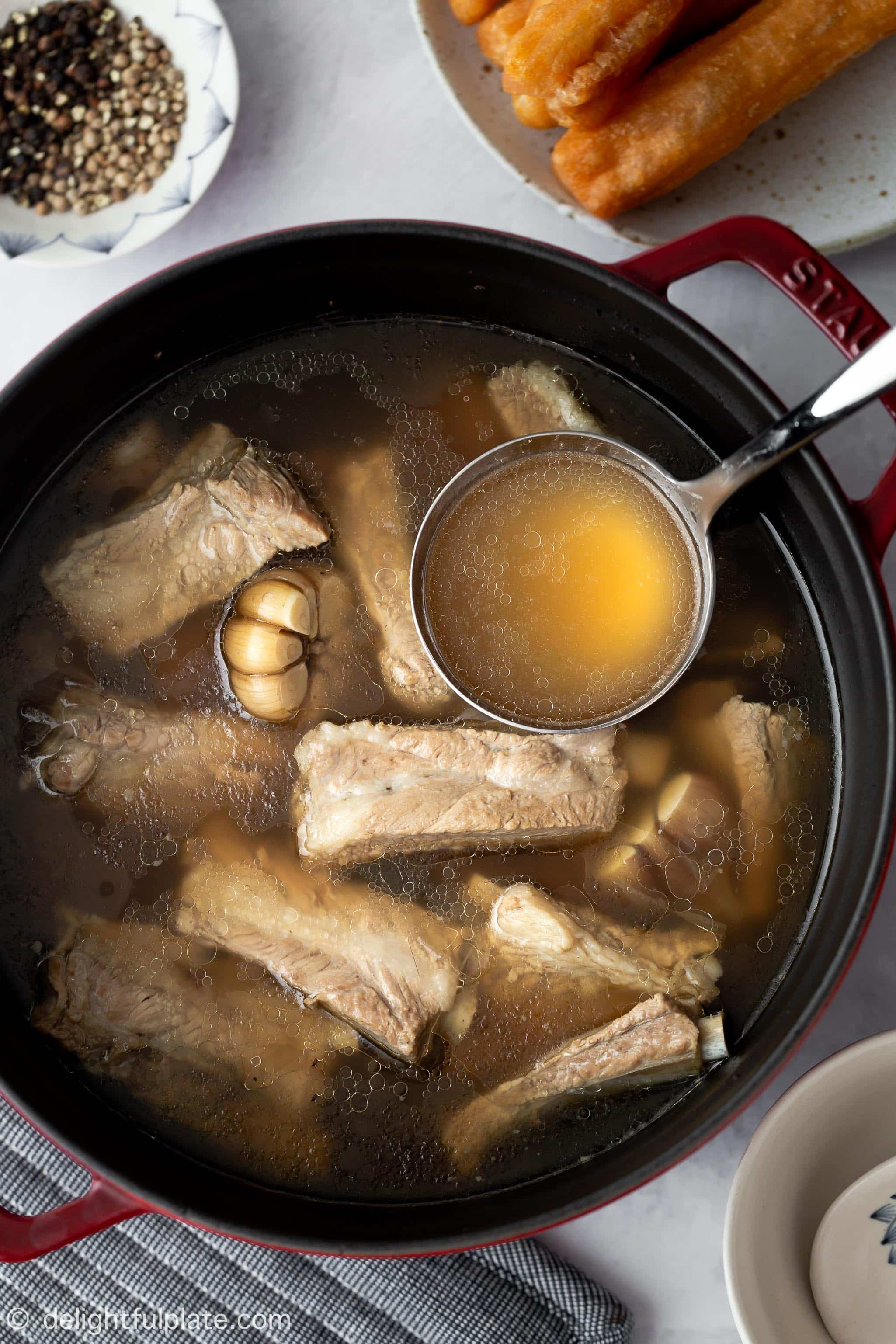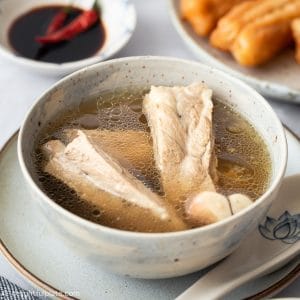Singaporean Bak Kut Teh (White Pepper Pork Rib Soup)
Singaporean Bak Kut Teh is a clear peppery soup made by simmering pork ribs with white pepper and garlic. This delicious soup is so fragrant, filling and comforting.

Bak Kut Teh can be translated as meat bone tea or pork rib tea. However, there is no tea in the soup. Instead, oolong tea is often served on the side with the dish to counterbalance the meatiness and richness of the soup.
There are different versions of bak kut teh. The Singaporean version of the soup is made with meaty pork ribs, a lot of white pepper and garlic. The Malaysian-style bak kut teh is darker with more herbs in the soup.
The Singaporean-style soup is often accompanied by steamed rice and crispy fried doughsticks (youtiao or Chinese crullers). I love to dip a piece of youtiao in the soup, then eat it with a spoonful of the spicy peppery broth – amazing!
Our favorite place to eat the soup in Singapore is Song Fa Bak Kut Teh. An order of this soup often comes with 2 to 3 tender and meaty ribs and the broth is refillable.

Use A Lot Of Peppercorns And Garlic
I guess restaurants in Singapore have secret ingredients in their recipes, but this homemade version definitely satisfies our cravings for Song Fa’s bak kut teh when we cannot fly to Singapore. The recipe is straightforward and requires very few main ingredients:
- meaty pork ribs,
- a lot of white peppercorns (a small amount of black peppercorns can also be added),
- a lot of garlic, and there’s no need to peel them (too time-consuming!).

White peppercorns give the dish its distinctive hot taste and floral fragrance. Please note that you need to use whole peppercorns, not ground white pepper. And if you have never tried or cooked this pork rib soup before, you may want to go easy with the amount of peppercorns.
If you cannot find whole white peppercorns at regular Western grocery stores, give Asian grocery stores a try or you can order some from Amazon. It is not possible to use black pepper in place of white pepper in this bak kut teh recipe.
I strongly recommend getting Chinese fried doughsticks (youtiao) to serve with this soup. I often buy them at Asian grocery stores and keep some in the freezer. When I need to serve them, I cut them into short sections and bake at about 400F for a few minutes until they are crispy. Or if you have extra time, make youtiao at home with my foolproof recipe.
How to Cook Singaporean Bak Kut Teh at Home

If you have a mortar and pestle, use that to crack some of the peppercorns open. It’s okay if some of them are still intact. Alternatively, place them in a ziploc bag, seal the bag and use something heavy to crack them open.
Don’t crush the peppercorns too hard, because if you crush them too much, the soup will look darker and taste spicier. Then toast the peppercorns and garlic briefly in a skillet. If you are short on time, it’s fine to skip the toasting step.

Whenever I cook pork rib soup, I always like to par-boil the pork ribs first to get a clear soup with a clean flavor. After that, we can simmer the ribs with peppercorns and garlic gently until the meat is tender. Season the soup with salt to your liking. So easy!
Bak kut teh is quite hearty in my opinion. However, if you want to keep it lighter and healthier, you can skim off some of the fat on the surface of the soup.
The soup will be even more delicious the next day in my opinion, so you can make a big batch and refrigerate the leftover. I hope you will give this bak kut teh recipe a try. It is an amazing dish to have on a cold or rainy day. Below is the recipe card with detailed instructions.

I’d love to hear what you think about the dish, so please feel free to leave a comment. New recipes are added every week so let’s connect on Facebook, Pinterest and Instagram for the latest updates.

Singapore Bak Kut Teh (Pork Rib Soup with White Pepper)
Ingredients
- 1.25 oz whole white peppercorns (about 1/4 cup plus 2 teaspoons)
- 0.15 oz whole black peppercorns (about 2 teaspoons)
- 2 oz garlic bulbs (about 20 cloves)
- 2 lbs meaty pork ribs, separated into individual ribs
- 6 cups water
- 2 teaspoons salt (to taste)
Instructions
- Use a mortar and pestle to lightly crack open the peppercorns. Alternative, place them in a sealed ziploc bag and use something heavy to crack open. It is fine if some are still intact. Rinse the garlic bulbs and cut off the bottom (no need to peel them).
- Place a skillet over medium-low to medium heat, toast the peppercorns and garlic bulbs briefly until fragrant.
- Bring a pot with plenty of water to a boil then add pork ribs and a pinch of salt. Bring it back to a boil and continue to parboil for 1-2 minutes. Discard the liquid and rinse the ribs.
- Clean the pot or use a different pot, add pork ribs, 6 cups of water and 1/2 teaspoon of salt. Bring to a boil, then lower the heat to a gentle simmer, skim off any foams. Add peppercorns and garlic.
- Use low heat to maintain a gentle simmer with the lid slightly askew (to leave a small space between the lid and the rim of the pot). Simmer until ribs are tender, about 90 minutes. Add the remaining amount of salt or to taste.
- Serve the soup hot with steamed rice, youtiao (Chinese fried doughsticks), oolong tea, some soy sauce and bird's-eye chili on the side.







Really delicious!! My husband who is from Singapore found this and asked if I could try it. I’ve made it three times now and it’s always yummy. DH says the flavor reminds him of home and he never comes back from the supermarket without pork ribs now. We love the heat so I use a half a cup of the white peppercorns and increase the water to make more broth. I’ve found that the peppercorns give off an odor when toasted that may not be for everyone but don’t be discouraged- this soup tastes incredible. Also, don’t skip the par-boiling step. It really does make for a clearer, nicer broth. Finally, I tend to make it in the early afternoon and let it simmer for as long as I can before we eat it, about 3-4 hours. The meat just falls off the bone and is perfectly tender. I never bother trimming the fat off the ribs bc it’ll melt away during the cooking process.
Hi Karen,
Thank you for such a detailed feedback, and I greatly appreciate the rating. I’m really happy both you and your husband, a Singaporean, enjoyed it. Bak kut teh will always be one of my most favorite soups. I actually feel that the soup somehow tastes even better the next day, so we like to make a big pot to have leftover for the next day.
This recipe tastes really similar with Song Fa. As a Singaporean who now lives overseas, I thank you!
Hi Antara,
Thank you so much for your kind words! I’m really happy to hear it. I actually just made this for dinner today and it brought back many good memories of Singapore.